The Samsung Galaxy Note5 and Galaxy S6 edge+ Review
by Joshua Ho on October 2, 2015 8:00 AM ESTBattery Life
Battery life is undoubtedly one of the most important parts of the user experience of any mobile device. One of the major reasons why many people use phablets is to get better battery life, as the PCB size of a phablet is often roughly similar to what you’ll see in a smartphone, but the battery will be bigger to fill the available space. As a result, a phablet has a higher proportion of battery than a smartphone. This inherently means that battery size will scale faster than platform power. In order to test this metric, we use a number of different tests ranging from display-bound web browsing to SoC-bound CPU and GPU load tests. In order to eliminate confounding variables, we test all devices from the same ASUS RT-AC68U router for WiFi testing, and in strong LTE/3G reception for mobile web browsing, in addition to setting all devices to an average of 200 nits on the display.
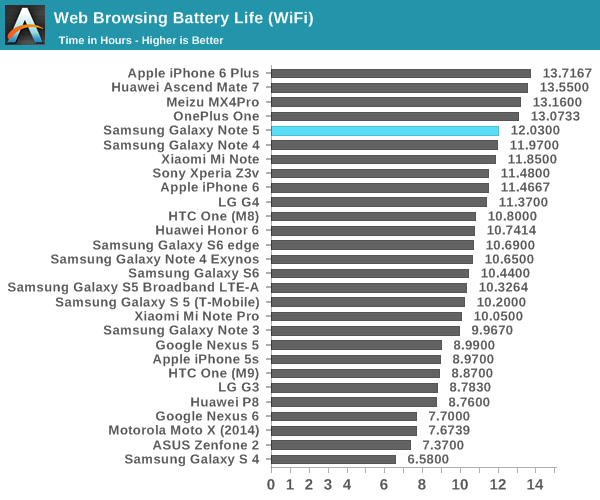
In our first test of WiFi web browsing, the Galaxy Note5 performs identically to the Galaxy Note 4. This might be surprising because the display is the same size and resolution as the Galaxy Note 4 with a smaller battery than the Galaxy Note 4. However, the smaller battery is compensated for due to improvements in SoC and display efficiency. In particular, the move from a planar 28nm process to a 14nm FinFET process dramatically reduces power consumption on the SoC.

In LTE battery life, we see a noticeable drop relative to WiFi battery life. It’s likely that this is mostly due to the power consumption of the Shannon 333 modem present in these devices. There’s not much else to say here, but battery life is still good.
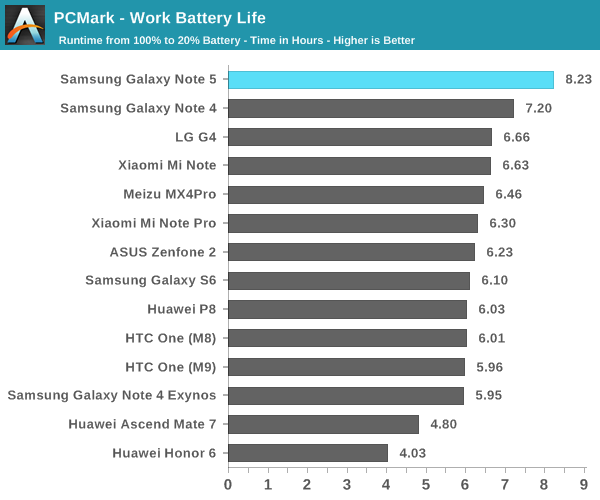
Moving past our mostly display-bound web browsing test, PCMark provides a much more balanced look at battery life as APL tends to vary a bit more with content like videos and photos instead of just webpages, and the CPU component is much more strongly emphasized. Here we can really see the Note5’s Exynos 7420 stretch its legs as it keeps a high performance level with long runtime.
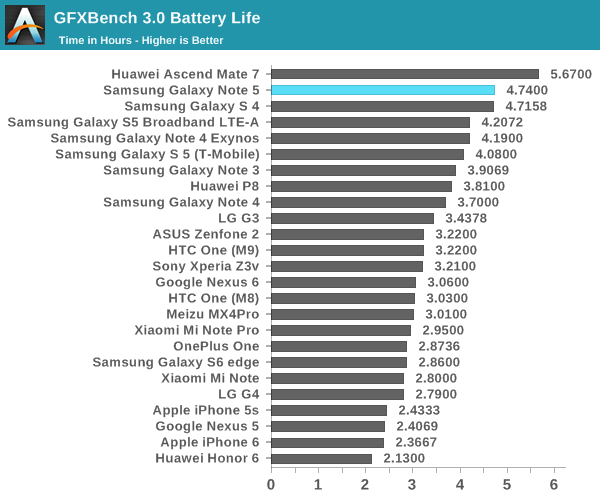
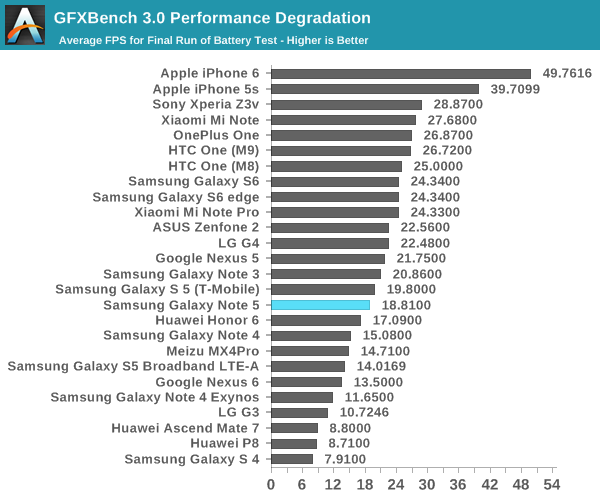
In our sustained SoC-bound workloads, GFXBench shows a healthy improvement over the Galaxy S6. Although we’re unable to test in perfectly controlled temperatures, it looks like Samsung has improved the throttling behavior of the SoC as the throttling appears to be more graceful rather than sinusoidal, and the result is a pretty significant jump in runtime over most devices.
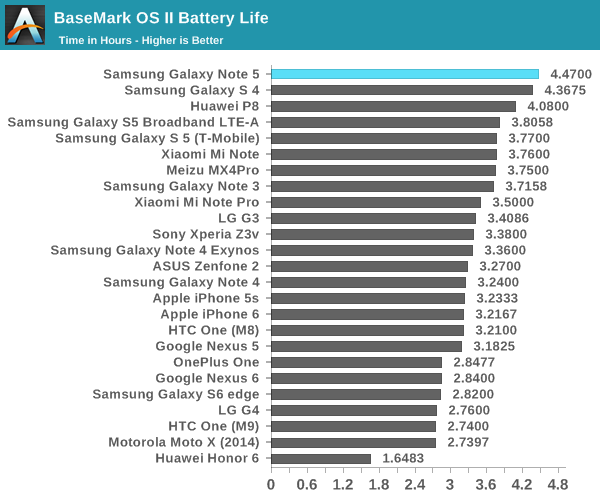

In Basemark OS II, we see a pretty significant uplift in runtime when compared to something like the Galaxy S6 or Note 4. The runtime increase isn’t just due to excessive throttling though, as the battery score shows that this isn’t just a case of throttling the CPU until the runtime is an improvement over past devices.
Overall, if you’ve read the Galaxy S6 review it’s pretty fair to say that you’ll know what to expect from the Galaxy Note5. Battery life is roughly equivalent to the Galaxy Note 4 despite the smaller battery, and due to the greatly improved Exynos 7420 SoC relative to 2014 SoCs SoC-bound cases will show pretty healthy improvements as long as you’re controlling for performance.
Charge Time
While normally battery life is the primary area of concern for a smartphone, in some cases it’s important for a phone to charge quickly. We can all claim to be perfect but one of the simplest cases for faster charging is forgetting to plug the phone in before going to sleep, so the maximum allowable charge time goes from something like 6 hours to an hour at best. As a result, a faster charger can dramatically improve practical battery life in any situation where you have limited time to charge. This can be accomplished by increasing either the current or voltage of the charger. The original quick charging standards improved charge rate through higher current, but this eventually hits a wall due to resistance in the wire. In order to increase the total amount of power delivered without increasing the thickness of the cable used voltage was increased in the case of newer standards like QC 2.0. In the case of the Galaxy Note5 and Galaxy S6 edge+, we’re looking at the same 9V, 1.67A QC 2.0 compatible charger that shipped with the Galaxy Note 4. In order to test this properly, we log the time it takes for the phone to charge by running a timer until the charger power draw hits a point that represents 100% battery.
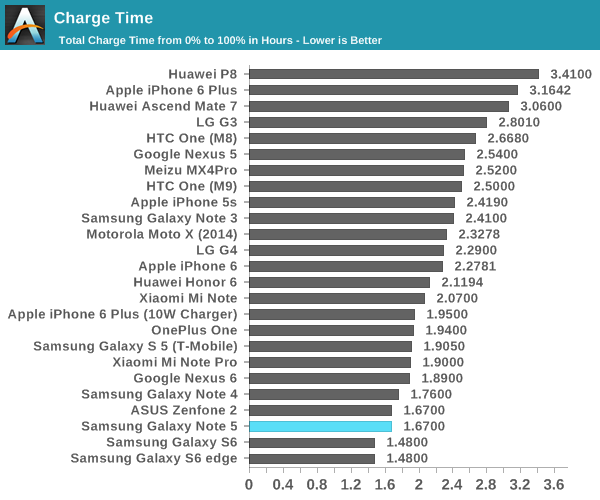
It probably isn’t a surprise, but charge time ends up similar to the Galaxy S6 and Galaxy Note 4. I suspect that we’ll be waiting until QC 3.0 to be able to see significant improvements as the current standard doesn’t have particularly fine-grained voltage scaling according to cable and phone conditions. Interestingly, the wireless fast charger is actually not too far off from the wired charger as it indicates 100% around 1.84 hours into charging which is almost identical to the wired fast charger.


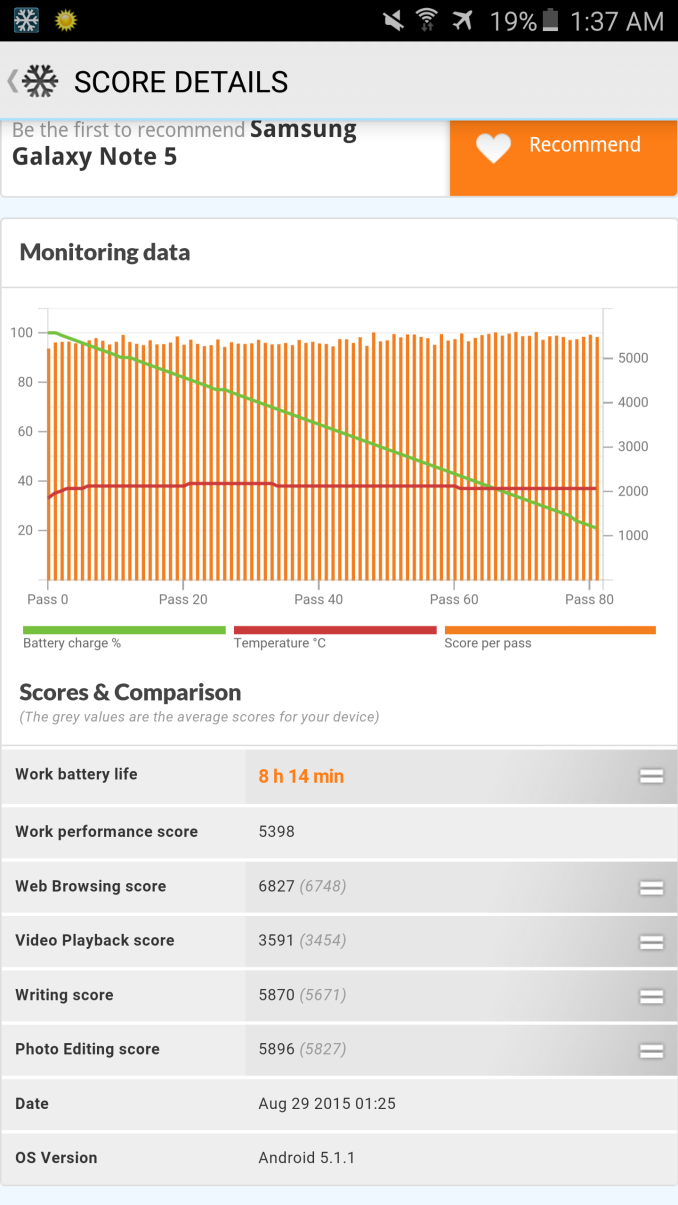
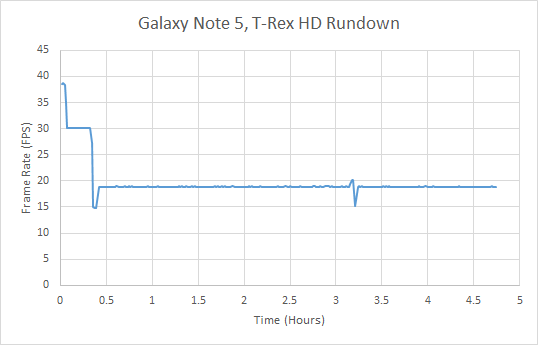
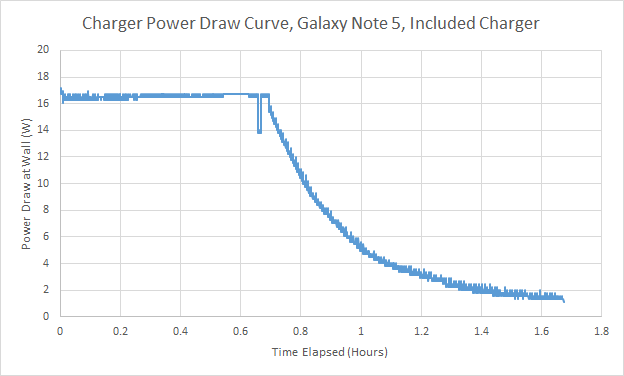
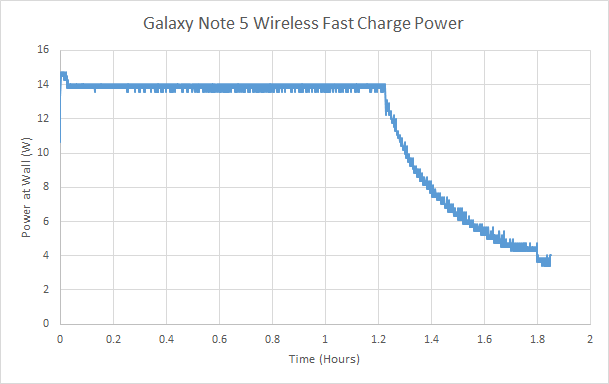








225 Comments
View All Comments
theduckofdeath - Thursday, October 8, 2015 - link
There are issues for desktop sized high resolution displays. The biggest one is volume and production cost. Just look at what you have to pay for an LG OLED telly compared to a nano LED telly. Like Kamus said, look up what professional display calibration companies says about SAMOLED. It's not "on par", it's in a league of its own.thedons1983 - Sunday, October 18, 2015 - link
You are an idiot. The reason that top end monitor manufacturers don't use OLED, or AMOLED, is because they can't afford to. Eventually they will replace LCD, when they can afford to. LCD is crap technology and outdated, and will eventually be entirely replaced, when the costs make sense. Samsung can produce AMOLED screens, because they actually build them!! Apple builds nothing. At all. They buy their tech from others whom have the know how. Therefore, they pay through the nose for it, and aren't ever even offered the superior tech, because, why would you bother?! You'd maybe understand these issues, we're you not such an utter moron.sany - Monday, October 5, 2015 - link
HiI've been wondering, having the best chip to process still photos and good software - why still slow motion FPS rate is still kept too low compared to the slow motion fps for iPhone. Is this a limitation with hardware or can be fixed through an software update?
thedons1983 - Sunday, October 18, 2015 - link
Dude, seriously, smartphones take terrible pictures. The camera tech they employ is light years behind that used in actual cameras. Any photographer using their smartphone as there primary photographic device, is an utter moron!! Probably an unsuccessful one too!!Peichen - Monday, October 5, 2015 - link
As an iPhone user that also played with Samsung and LG flagships extensively, I feel Samsung Galaxy S and Note are the only phone that can be mentioned in the same sentence as iPhone. No other Android phones come close to S and Note's Apple-like hardware and refinements. Android + TouchWiz still lags and not as stable as iOS but where Samsung did their homework it is at Apple's level. I hope the upcoming V10 and Z5 Premium is as well made and tweaked as Note 5.thedons1983 - Sunday, October 18, 2015 - link
Your opinion is entirely meaningless, as you haven't used any flagship Android devices, other than Samsung. Sony make great phones, as do HTC, and Google and Motorola, and Huawei... Need I go on?? You might know this, if you weren't so entirely blinkered and pathetic.jrich7 - Monday, October 5, 2015 - link
Just picked up a Note 5 today, ugraded from the Nexus 6 and wow its way faster ! The batter drains a little faster but the fast charge feels just sweet and that see coming from another fast charge device. The screen is beautiful and the spen is going to come in handy. The only thing I really like better in the Nexus 6 was the two front facing speakers. I thought I would not like TouchWiz because I heard it's slow compared stock androld but the hardware on the phone makes up for it like 10 fold ! I'm very happy with this device :)coolhardware - Tuesday, October 6, 2015 - link
The Nexus 6 had splendid speakers! That was my biggest complaint switching from it to a smaller Galaxy S6.For another set of nice stereo phone speakers, check out the Moto X Pure Edition. My wife has one and the speakers sound good, better than any phone from Samsung or Apple IMHO. :-)
Speaking of Apple, I am excited to hear the speakers on the new iPad Pro. I'm *hoping* they really advance the tablet speaker situation to a new level!
thedons1983 - Sunday, October 18, 2015 - link
Thank you! The opinion of someone who has actually bought the device in question, is always going to be more legitimate, than the reams of idiots who have only ever used an iPhone. Good work, for bothering to add your two cents, it is appreciated.Thounee - Monday, October 12, 2015 - link
Hey staff @ Anand. I tried to look for any review of Xperia's (Z3, Z3+/Z4 or new Z5's) but came up empty. Since the sensors and image/video quality is considered as best by some benchmarks in the industry (look at dxomark), it would be nice to see your take on the latest versions.